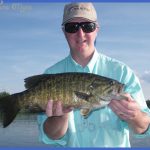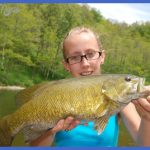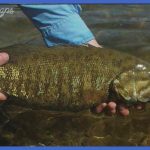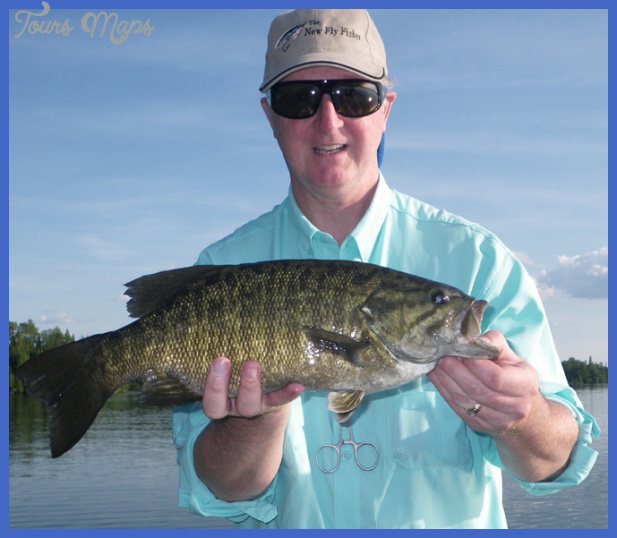Smallmouth bass, Micropterus dolomieui, abound in Maine, especially in the eastern part of the state. Unbelievably, some ponds contain so many smallmouth bass that there is no size or bag limit, although other species in the same body of water are regulated. Smallmouths are also found in many of Maine’s rivers and streams, where they provide action throughout the open water season. Maine’s record smallmouth bass weighed 8 pounds.
Smallmouth bass are tireless fighters, given to lightning-fast runs and spectacular aerial displays. Such is the tenacity of these dogged battlers that anglers often overestimate their size, at least until the fish is safely in the net. Landlocked salmon anglers sometimes think they have hooked the trophy of a lifetime, only to find a 4-pound smallmouth bass on the end of their line. A day spent catching 1- to 3-pound smallmouth bass may mean sore arms that night.
Smallmouth bass become active in early spring, as soon as the water temperature nears 60 degrees; they stay active through September. Spawning takes place in June. The fish are extremely susceptible during this period, and will strike anything that comes near the bed. Anglers should always release any bass in the same area it was taken from, or the fish may become disoriented and be unable to return to the bed.
Bass living in ponds become difficult to catch when the water temperature is over 75 degrees. Fish in rivers remain active all season, however, because rivers provide cool, well-oxygenated water.
Smallmouth bass feed on other fish, crayfish, hellgrammites, and, to a lesser extent, insects. Maine’s rocky lakes are such good smallmouth bass producers partly because of the large numbers of crayfish found in these lakes.
Techniques
Spin fishing – In spite of the smallmouth’s fearsome reputation, heavy tackle is not required to catch them, since they are primarily a fish of open water. Smallmouth bass prefer rocky bottoms, not weed-infested coves. Unlike largemouth bass, smallmouths can be leader-shy. Lines should be no heavier than 6-pound test, and 4-pound test will bring more strikes. Open-faced reels are more commonly used, but closed-faced reels will suffice. A smooth, positive drag is probably more important than reel style. Smallmouth bass are masters at shaking off lures, so your hooks must be needle-sharp. Keep a hook hone in your tackle box.
When casting, have your drag on a medium setting to facilitate setting the hook. Be ready to loosen the drag when the fish makes a run. Improper drag adjustment probably accounts for more lost fish than any other factor. You must be able to sense when to use muscle and when to simply keep a tight line. Perhaps the most critical moment occurs when the fish is about to be netted. An unexpected burst of energy at the last moment can cause a broken line if the drag is set too tightly.
At one time, Daredevle spoons were used by more Maine smallmouth bass anglers than any other lure. The Daredevle is still a good choice, and you should have several in your tackle box, especially the red-and-white variety. Daredevles and similar spoons are highly effective for fishing from a lakeshore, since they have little wind resistance and can be cast a great distance. A lip-hooked bass can easily throw a spoon, so always keep your rod high in order to maintain tension.
Plastic grubs attached to a jig head are a highly effective combination. The plastic bodies come in an amazing variety of sizes, scents and colors, but they all have one thing in common: the fish are reluctant to spit them out. This allows for some degree of angler error in detecting a strike.
If you are fishing a river, cast the grub/jig combination toward whatever cover you can find, especially behind large boulders. Allow the jig to settle and gently twitch it back to shore. Fish will often take the jig as it sinks toward bottom, so be ready to strike if you notice slack line.
When fishing lakes and ponds, concentrate on rocky shorelines, especially around points of land. Cast your jig toward shore and fish it as described above. In summer, when the fish are in deeper water, you can drift in 20 to 40 feet of water. Drag the jig combination on bottom, and impart action by lifting it about a foot from bottom, then allowing it to settle back.
Spinners such as the Mepps are effective on smallmouths, especially in rivers. Fish the spinner as if it were a wet fly. That is, cast quartering upstream and slowly retrieve the spinner as it is carried downstream. To find out how deep the fish are holding, begin counting after the spinner hits the water. Start by counting to five, and then retrieving. If you get no action, increase the count until you find fish.
Minnow imitations such as Rebels and Rapalas are topnotch smallmouth lures, effective when casting or trolling. If you choose to troll, use the diving variety, the kind with the lip in front. Adjust your speed so the lure is riding within a foot of bottom. The faster you go, the deeper the lure will ride. Troll just off the shorelines, near points, and around rocky islands. This is a highly effective method for smallmouth bass in slow-moving rivers. Carry some lures in fluorescent orange, as these can take fish when nothing else works.
Fly casting – Smallmouth bass provide great surface sport, especially during the early morning and evening hours. Fly pattern isn’t as critical as in trout fishing, but you should try to duplicate the shade and size of any natural insects that might be on the water.
You do not need a heavy fly rod, unless you are fishing one of the larger lakes where wind may be a factor. On calm days, you can get by with a 5- or 6-weight rod and line. Reels should have an effective drag.
If you wish to surface fish during the daylight hours, try small fly-rod poppers, as well as deer-hair bugs. You might want to use a weight-forward floating line, since poppers and bugs are difficult to cast due to increased wind resistance.
Anglers armed with a high-density sinking fly line and a few leech patterns can have a heyday with smallmouth bass. Woolly buggers, muddlers, and Matukas are also good choices. Cast the fly toward shore if fishing a lake and toward quiet sections of pools if fishing rivers. Allow it to sink and retrieve either by raising the rod and then dropping it, or by the hand-twist method. Sometimes the fish will nearly tear the rod from your hand, but other times they simply inhale the fly and hold it until you detect their weight.
Bait casting – Lightweight, modern bait casting reels and rods are suitable for smallmouth bass fishing, although few Maine anglers use them. An especially good technique is to use one of the so-called stick lures, the simple floating lures that require the angler to supply the action. When twitched, these lures dart about like a wounded minnow. They drive smallmouth bass wild.
If you use the old-style braided casting line, use a short section of monofilament leader on the end. Otherwise, standard monofilament is fine.
Because bait casting tackle allows the angler to cast and recast so rapidly, it is perfect for when you are floating down a river, where you do not get the opportunity to cast more than once to any particular spot.
Use the same lures mentioned in the section on spin fishing and fish in the same spots.
Bait fishing – Hellgrammites and crayfish are both top smallmouth baits. Note that it is illegal to import hellgrammites into Maine. They are also hard to find in stores, so you might want to learn how to harvest them yourself. A good way to do that is to take a section of fine screen and have someone hold it at a 45-degree angle in a stream. Go above the person holding the screen and turn over rocks. The hellgrammites will float downstream and be trapped on the screen. Hook hellgrammites through the collar and hook crayfish through the tail. Use little or no added weight and allow your bait to move about on bottom in a natural manner. When using crayfish, you may need to remove the large claw to keep the bait from grabbing hold of underwater debris. Live minnows and night crawlers are also effective when fished in this way.
Ice fishing – Smallmouth bass bite well in winter, but few Maine anglers fish for them. Set your baited tip-ups in from 10 to 20 feet of water, preferably around rocky points.
Smallmouth bass usually run a considerable distance when they first hit a bait. Allow the fish to take line before picking up your tip-up. When the fish stops running, wait until it takes off again before setting the hook.
Smallmouth bass also respond to ice jigs. A lightweight jig rod and ultralight reel are perfect for jigging for smallmouths.
Best bets for Maine smallmouth bass: Indian Pond, Site 67; Junior Lake, Site 59; Penobscot River, Site 46; Kennebec River, Sites 35 and 37; and West Grand Lake, Site 58.
Fishing: Smallmouth Bass Photo Gallery
Maybe You Like Them Too
- The Best Cities To Visit in The World
- World’s 10 Best Places To Visit
- Coolest Countries in the World to Visit
- Travel to Santorini, Greece
- Map of Barbados – Holiday in Barbados






